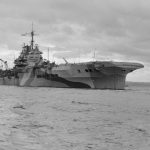
Battle of Cape Matapan

After France’s capitulation, Britain stood alone. The Sovok* intensively prepared for major war but was still engaged in non-military seizure of western territories. The US, though providing aid to Britain, wasn’t even planning to actively join the fight at that moment. Since Britain located on islands, its main weapon became the fleet, and the main battlefield — maritime communications. Considering they had to rely primarily on their own forces, industry required doubled effort as it shifted to wartime operation mode. Most of the raw materials lay in Asian colonies, reachable only by sea. The shortest route there went through Gibraltar and the Suez Canal, across the entire Mediterranean Sea. This vital artery would soon become the stage for the Battle of Cape Matapan, where Italian ambitions to control these waters would meet their catastrophic end.
Mussolini’s Mission
This very artery Mussolini had to sever with his fleet forces. Given Italy’s geographic position, which almost bisects the sea in half, its role in cutting British maritime communications was obvious.
The Italian fleet, though well-equipped, lacked positive experience in major naval battles, unlike its opponent. Therefore, it operated not far from its bases and didn’t have the scope with which the British acted. In turn, London was obliged to help Greece, which sided with Britain, with something at least. Hitler tasked Mussolini with establishing order in his sea.
Hitler conveyed to Mussolini the idea that while Germany could back its ally on land — which it later demonstrated in the Balkans and North Africa — at sea the duce must act independently and very decisively. Moreover, home bases stood close to the operational area, so such confrontation wouldn’t require special effort. There was nothing to counter, and on March 26, 1941, the Italian fleet began executing Operation Gaudo.
Operation Gaudo
The operation’s design aimed to prevent British fleet support to Greece, where the British squadron was heading. It consisted of three battleships: Barham, Valiant, and Warspite, seven light cruisers, and seventeen destroyers. But the British had that very weapon the opponent lacked—the aircraft carrier Formidable. Italians believed that operating at short distance from bases, they could ensure air cover through coastal aviation.
The British fleet, though consisting of major ships from World War I times, had managed to modernize them. Part of the ships had radars and other technical novelties allowing them to see the enemy even at night or in bad weather. Plus, everyone remembers the story of the German “Enigma” — the captured cipher machine that allowed breaking codes and gaining access to Third Reich secret correspondence? The British also broke Italian codes, though this isn’t particularly talked about. As a result, the Italian squadron received orders for conducting its combat operation simultaneously with the British, and they knew what forces would await them and where.
The Clash Begins: Battle of Cape Matapan
Therefore, the British put forward their light cruisers, which were supposed to detect the enemy. On March 28, opponents found each other near the Greek Cape Matapan. A small group of British light cruisers spotted a group of Italian heavy cruisers, and those immediately opened fire. The British recorded that the enemy fired 535 eight-inch shells at them, but skillful British maneuvering and imperfect Italian aiming equipment brought the shooters not a single hit. Thus began the Battle of Cape Matapan, named after the nearest cape.
Heavy cruisers, fearing a British trap and not fully understanding what force composition stood before them, turned toward their battleships. The British understood this maneuver and followed. Nevertheless, attacking battleships with light cruisers was useless. British battleships stood quite far from the fight location, so carrier aviation entered action. Swordfish torpedo bombers attacked the Italian fleet’s main core and managed to damage the group’s flagship—battleship Vittorio Veneto. A torpedo hit the stern and damaged the propellers. Though the ship didn’t lose speed completely, it lost half its speed. Heavy cruiser Pola got much worse. A torpedo hit the engine room and it completely lost speed, becoming an easy target for any opponent.
Admiral Iachino’s Fatal Decision
The Italian group commander, Admiral Iachino, decided to retreat to base since losses proved too heavy, and the main part of the British fleet hadn’t even approached. Yet he didn’t dare abandon cruiser Pola, since this would be not just defeat but disgraceful defeat. Under night cover, he sent two more heavy cruisers Fiume and Zara to rescue the damaged cruiser, with an escort of four destroyers. They were supposed to ensure Pola’s towing to fleet base for repair.
The task seemed simple, but towing the heavy cruiser that lost speed succeeded only at low speed. Meanwhile, the British fleet’s main group, including battleships, approached this location. They came to short range and simply destroyed all three heavy cruisers plus two destroyers that couldn’t escape the fight location.
Catastrophic Defeat
A one-time loss of such quantity of heavy ships brought Regia Marina command into confusion state. They simply imagined what would have happened to the remaining ships of their group if two fleet groups had collided on combat course. The Battle of Cape Matapan proved that carrier aviation and modern technology decisively outmatched traditional naval tactics. The Italian fleet never again attempted to claim dominance in the Mediterranean Sea.
Related posts:
